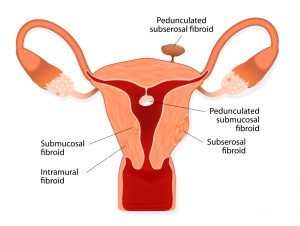How Fibroids Affects Your Life
- Details
- by: Leah Johnson
Fibroids are growths that appear on the uterus that range from so small they cannot be seen to large enough that they can obstruct the entire opening to the uterus. While they are noncancerous and are not associated with cancer risks, they can be extremely painful and have other negative effects on your health.
Fibroid Types

Intramural Fibroids
The most common type are intramural fibroids. These are on the endometrium, or within the lining of the uterus. They sometimes can grow in size and make the womb bigger. Some people will mistake the feeling of having this mass for being pregnant. The pain from this type can go from non-existent to extremely painful, causing many women to feel some immense pressure in their pelvic regions day in and day out. It can also lead to excessive menstrual bleeding.
Subserosal Fibroids
These fibroids form around the outside of the uterus and can also stretch the womb on one side. Although this particular type does not cause bleeding issues , it can still cause a lot of back and pelvic pain due to the extra pressure being put in the area. It can also push itself against the other organs in the area, like the kidneys.
Pedunculated Fibroids
These are suberosal fibroids that have grown a stem. These stems can cause the fibroid to grow into the uterus further, or push itself out of the wall. The pain from these usually comes from the stalk end of it to twist.
Submucosal Fibroids
These are the type that grow on the myometrium of your uterus, which is its lining. These cause problems with conceiving and can lead to extreme menstrual bleeding. These are the least common type, but the most painful. If left unchecked, these can lead to issues like anemia, extreme fatigue, pregnancy problems, and could lead to the need of a blood transfusion.
Where do Fibroids Come From?
For the most part, there is no complete picture on where fibroids come from and what causes them. However, medical professionals believe that it could be a combination of hormones, family history and pregnancy. Estrogen and progesterone are the main hormones that help the uterine lining regenerate during menstruation, so it is possible that elevated levels of them can promote fibroid growth. There is also a possibility that it is genetic, although they are so common that it is a bit unclear. Nearly 80% of women will experience them before the age of 50, according to the NIH.
 What are the Symptoms?
What are the Symptoms?
Some women experience no fibroid symptoms at all and are completely unaware of even having them. However, for other women, the symptoms are often severe and painful. Menstrual periods can become extremely heavy and can last longer than the normal length of time.
Sometimes the tumors are so big that they press against other organs, causing extreme pain in the pelvic regions. They can also cause you to have to urinate frequently. Even your sex life can be effected, as they become so large that intercourse becomes painful and uncomfortable. Finally, can lead to complications during childbirth and other fertility issues.
What is the Cure?
Unfortunately, there is no actual cure for the disease. However, several procedures and medicines have been created to help deal with the issue.
A lot of misinformation is out there about fibroids. A lot of women fear that the only way to get rid of the problem is through a hysterectomy. For women who are planning on having kids, this solution is a heavy price to pay. While it is true that a hysterectomy will get rid of the fibroids by eliminating a place for them to grow, it is the most extreme solution and in most cases only the final one. The good news is that there are many other options available before that should ever be considered.
One of the less destructive ways to deal with fibroids is uterine fibroid embolization, also known as UFE. UFE is a procedure that is done by an experienced physician and is an alternative to surgical methods.
How Does UFE Work?
Before going in for a UFE, your doctor will give you instructions on when you should stop eating or drinking. They will then give you a sedative and prepare you for the procedure.
A catheter is then inserted into your femoral artery. Contrast material is injected so the physician can see your arteries in real time. They will then guide the catheter around to the arteries leading into the fibroids and then inject a solution that will cut blood flow to the fibroids, which will cause them to shrink and be destroyed.

 What are the Symptoms?
What are the Symptoms?